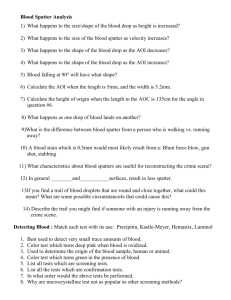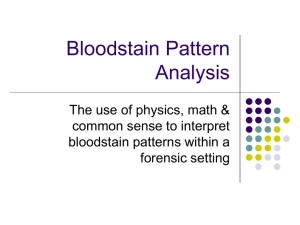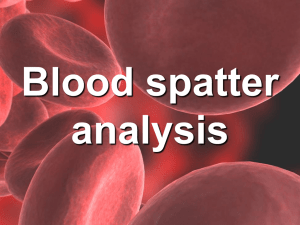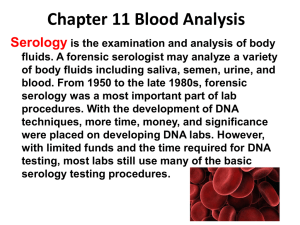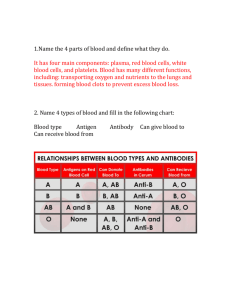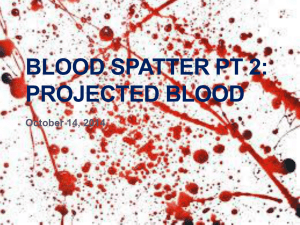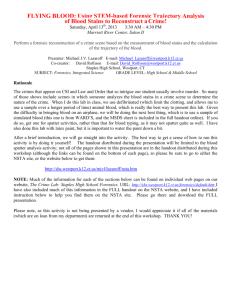Serology
advertisement
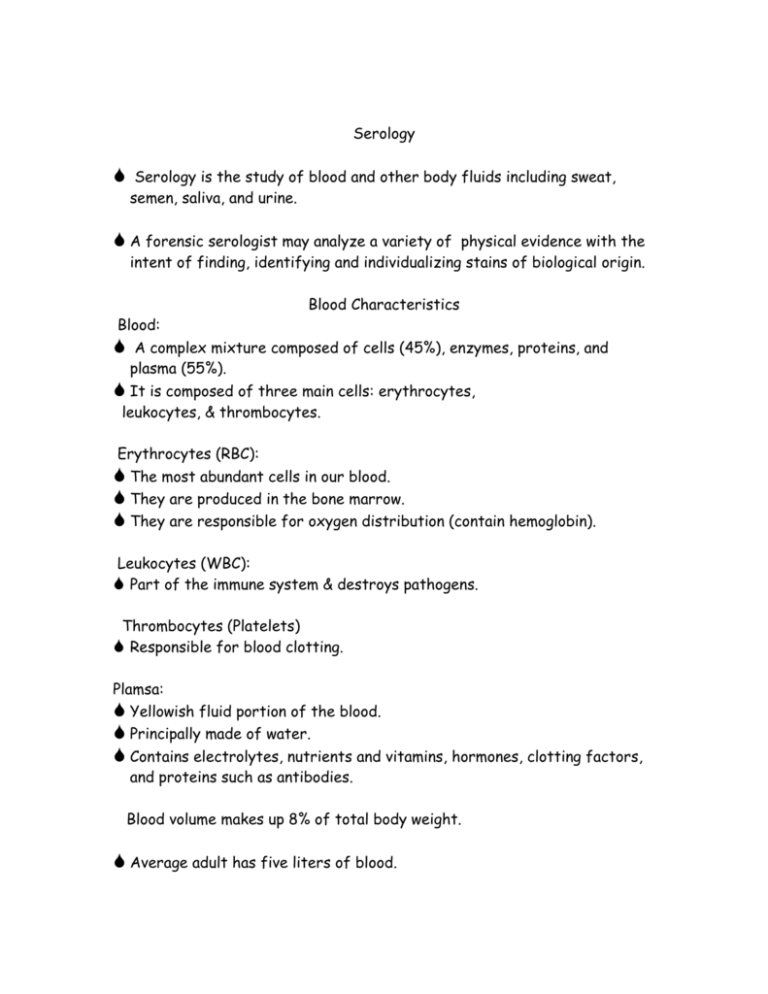
Serology Serology is the study of blood and other body fluids including sweat, semen, saliva, and urine. A forensic serologist may analyze a variety of physical evidence with the intent of finding, identifying and individualizing stains of biological origin. Blood Characteristics Blood: A complex mixture composed of cells (45%), enzymes, proteins, and plasma (55%). It is composed of three main cells: erythrocytes, leukocytes, & thrombocytes. Erythrocytes (RBC): The most abundant cells in our blood. They are produced in the bone marrow. They are responsible for oxygen distribution (contain hemoglobin). Leukocytes (WBC): Part of the immune system & destroys pathogens. Thrombocytes (Platelets) Responsible for blood clotting. Plamsa: Yellowish fluid portion of the blood. Principally made of water. Contains electrolytes, nutrients and vitamins, hormones, clotting factors, and proteins such as antibodies. Blood volume makes up 8% of total body weight. Average adult has five liters of blood. A 40% (2L) loss of total volume results in irreversible shock (death). A 1.5L loss of total volume results in disabling a person. There are one billion RBC in 2-3 drops of blood. For every 600 RBC, there are about 40 platelets and one WBC. Blood Terminology Antigens: Responsible for blood type characteristics. On the surface of RBC. A protein that stimulates the immune system to produce antibodies. More than 15 blood antigen systems have been identified. Antibody: A protein that reacts with an antigen. Produced by WBC. They recognize and bind to certain, specific antigens (agglutination). Agglutination: Clumping of RBC which occurs if blood types with different antigens are mixed. ABO System Karl Landsteiner (1901) Discovered the ABO blood system of blood typing. Leon Lattes (1915) Discovered a way of typing dried blood using saline to determine the ABO system. Blood type is inherited. It can be used to include or exclude a person as a suspect. It can not absolutely identify a suspect. It can absolutely exclude a suspect. The groups are based on having an A,B, both or no antigens on RBC. There are four different blood types: A,B,AB, and O. ABO System Blood Type Antigens on RBC Antibodies A A Anti-B B B Anti-A AB AB none O none Both Anti-A & Anti-B ABO System Blood Type Reaction w/ Anti-A Reaction w/ Anti-B A Agglutination No Agglutination B No Agglutination Agglutination AB Agglutination Agglutination O No Agglutination No Agglutination Distribution of blood types: ABO System Distribution of blood types: Blood Type Percentage of Population A 40% B 11% AB 4% O 45% ABO System Rh Factor (+ or -) Rh stands for rhesus factor, first identified in rhesus monkeys in 1940. Rh is antigen D on the surface of RBC. It is inherited separately from the A & B antigens. Presence of antigen D, Rh positive. Absence of antigen D, Rh negative. 85% of Caucasians, 94% of African Americans, and 99% of all Asians are Rh positive. Blood Donation AB is the universal recipient. O is the universal donor. If you are Rh +, you can accept + or – . If you are Rh -, you can only accept -. Analysis of Blood Three questions must be answered by the forensic serologist: 1. Is it blood? 2. Is it human blood? 3. Can it be associated with an individual? Analysis of Blood Is it Blood? (Presumptive Tests) Kastle-Meyer Color Test: -Phenolphthalein, hydrogen peroxide, and suspected blood stain are mixed; positive reaction indicated by a deep pink color. -It reacts with iron in hemoglobin to produce a pink color. Is it Blood? (Presumptive Tests) Kastle-Meyer Color Test: -Results are not definite. -Substances other than blood may produce the color change (potatoes and horseradish). Is it Blood? (Presumptive Tests) Hemastix Test: -Used in the field by investigators. -A dipstick moistened with distilled water is placed in contact with the suspect blood. Is it Blood? (Presumptive Tests) Hemastix Test: - It reacts with iron in hemoglobin causing a green color change. Is it Blood? (Presumptive Tests) Luminol Test: -A test for blood that produces light (luminescence) when it reacts with blood. Is it Blood? (Presumptive Tests) Luminol Test: -Extremely sensitive-it is capable of detecting blood stains that have been diluted up to 300,000 times. Is it Blood? (Presumptive Tests) Luminol Test: -Limitations: 1. Reacts with copper containing alloys, certain bleaches and citrus fruits. 2. Residual bleach will cause the entire scene to glow. Analysis of Blood Is it Blood? (Presumptive Tests) Luminol Test: -Limitations: 3. Its presence prevents other tests from being performed. (DNA analysis can still be performed). Analysis of Blood Is it Blood? (Presumptive Tests) Leucomalachite Test: -A mixture of acetic acid, distilled water, leucomalachite green, and sodium perborate will turn a sample green in the presence of blood. Analysis of Blood Is it Animal or Human? Precipitin Test: -Based on the theory of antigen-antibody reactions. -An animal (rabbit) is injected with human blood. -The animal creates antibodies that can be recovered and used to test for various human blood antigens. Analysis of Blood Is it Animal or Human? Precipitin Test: -The recovered antibodies are called human antiserum. Precipitin Test: -To test for human blood, human antiserum and an unknown blood are put together—if the blood is human a precipitate will form. Analysis of Blood Is it Animal or Human? Differences: -Platelets and leukocytes do not differ significantly. -Mature human RBC lack a nucleus. Analysis of Blood Can it be Individualized? DNA Analysis: -Characterizes bloodstains to a particular individual using blood factors. Blood Spatter Interpretation It applies principles from biology, chemistry, physics, and math to interpret bloodstain patterns within a forensic setting. It is used to determine what happened at a crime scene & the sequence of events that took place. It can determine: -Location and description of individual stains and patterns -Mechanism that created the stains -Direction blood droplet was traveling Blood Spatter Interpretation -Origin of bloodstain -Position of victim & assailant -Distance of bloodstain from target -Speed with which blood left its source -Minimum number of blows Blood Spatter Interpretation Blood drop characteristics: -A free falling drop of blood forms a sphere or ball. -The spherical drop will break when it strikes another object or when acted upon by some force. Blood Spatter Interpretation -Blood droplet volume is directly dependent upon the surface or orifice from which it originates. -The impact area it strikes is called the target. Blood Spatter Interpretation -The higher the height and the faster a drop falls the larger its diameter. -Texture of surface changes the shape of drop. Blood Spatter Interpretation Spatter size is dependent upon velocity : -Low Velocity -Results from the pull of gravity. - Spatter is 5 ft/s & usually 3 mm or greater in diameter . -Indication of dripping blood Blood Spatter Interpretation -Medium Velocity -Results from an object as a fist or blunt object. -Spatter is 5 – 25 ft/s with a <3 mm diameter. Blood Spatter Interpretation -High Velocity -Results from gunshots, power tools, an object striking with extreme velocity, or an explosion. -Spatter is 100+ ft/s with a diameter of < 1 mm. -May be referred to as fly specks Blood Spatter Interpretation Angle of Impact: -Angle at which blood strikes a target surface. -A droplet will remain spherical if it falls at a 90° angle. -Droplets elongate as the angle decreases from 90° to 0° Blood Spatter Interpretation -The more acute the angle of impact, the more elongated the stain. - At about 30° the stain will begin to produce a tail. Blood Spatter Interpretation Blood Spatter Interpretation The shape of a blood drop can be determined by the formula: Blood Spatter Interpretation Blood Spatter Interpretation Tail points in direction of travel. The Point of Convergence: -The intersection of two bloodstain paths, where the stains come from opposite sides of the impact pattern. Blood Spatter Interpretation The Area of Convergence: -The point of origin; the spot where the “blow” occurred. -Formed by the intersection of several stains from opposite sides of the impact pattern. Categories of Blood Stains Categories of Blood Stains Passive: Created when the force acting on the blood is gravity. Categories of Blood Stains Projected: Occur when some form of energy has been transferred to a blood source. Categories of Blood Stains Transfer or contact: Produced when an object with blood on it comes into contact with an object or a surface that does not have blood on it. Categories of Blood Stains Swipe: Created when wet blood is transferred to a surface which did not have blood on it. Categories of Blood Stains Wipe: Created when a nonblood bearing object moves through a wet bloodstain, altering the appearance of the original stain. Categories of Blood Stains Cast off: Created when blood is thrown from an object in motion. Categories of Blood Stains Arterial Spurting: Resulting from blood exiting the body under pressure from a breached artery. Secretors 80% of individuals are classified as secretors. This means that their blood type antigens are found in high concentrations in most body fluids (salvia, semen, gastric juices). Semen and salvia have a higher concentration of antigens than blood. Semen can be detected by two methods: -UV Light -Acid Phosphatase Color Test UV Light -Semen will fluoresce under UV light when it comes in contact with 4-methyl umbelliferyl phosphate (MUP). Secretors Acid Phosphatase Color Test - Acid phosphate is an enzyme secreted by the prostate gland into seminal fluid that is in far greater concentrations than those found in any other body fluids. -Its presence can be detected by placing sodium alpha naphthylphosphate and Fast Blue B solution are on it. -Large areas or fabrics can be quickly searched by moistening filter paper with the detector solutions and rubbing over the suspect area. Secretors Secretors Secretors -Some substances will give a false-positive result (fruit juices), but none of these substances will react with the speed of seminal fluid. -It turns a purple color if it is present. -If a false-positive results occur then p-30 or prostate specific antigen (PSA) is used to detect seminal plasma. Secretors Secretors -Formation of a visible line between the wells of anti p-30 and semen extract–proves the stain is seminal. People of Historical Significance Paul Kirk (1902-1970) was a professor of criminalistics and biochemistry at Berkeley in California. He actively assisted law enforcement organizations from 1935 to 1967. His book, Crime Investigations, contained a chapter in which he discussed the application of blood stain pattern analysis to criminal investigations. Dr. Kirk analyzed the blood stain pattern photos from the Sam Sheppard case and was instrumental in Sheppard’s release at his second trial.
